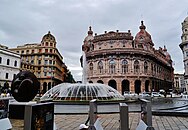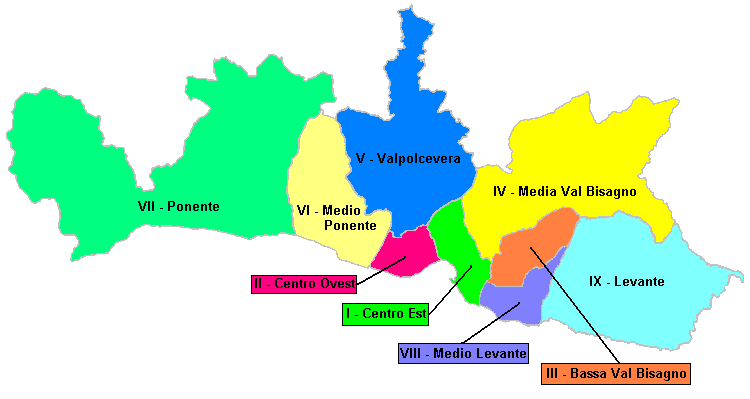Genoa
Genoa
Genova ( Ligurian) | ||
|---|---|---|
| Comune di Genova | ||
Skyline of Genoa | ||
ISTAT code 010025 | | |
| Patron saint | John the Baptist | |
| Saint day | 24 June | |
| Website | comune | |
| Official name | Genoa: Le Strade Nuove and the system of the Palazzi dei Rolli | |
| Criteria | Cultural: (ii)(iv) | |
| Reference | 1211 | |
| Inscription | 2006 (30th Session) | |
| Area | 15.777 ha (38.99 acres) | |
| Buffer zone | 113 ha (280 acres) | |
Genoa (
On the Gulf of Genoa in the Ligurian Sea, Genoa has historically been one of the most important ports on the Mediterranean: it is currently the busiest in Italy and in the Mediterranean Sea and twelfth-busiest in the European Union.[5][6]
Genoa was the capital of one of the most powerful maritime republics for over seven centuries, from the 11th century to 1797.[7] Particularly from the 12th century to the 15th century, the city played a leading role in the commercial trade in Europe, becoming one of the largest naval powers of the continent and considered among the wealthiest cities in the world.[8][9] It was also nicknamed la Superba ("the proud one") by Petrarch due to its glories on the seas and impressive landmarks.[10] The city has hosted massive shipyards and steelworks since the 19th century, and its solid financial sector dates back to the Middle Ages. The Bank of Saint George, founded in 1407, is the oldest known state deposit bank in the world and has played an important role in the city's prosperity since the middle of the 15th century.[11][12]
The historical centre, also known as old town, of Genoa is one of the largest and most-densely populated in Europe.[13] Part of it was also inscribed on the World Heritage List (UNESCO) in 2006 as Genoa: Le Strade Nuove and the system of the Palazzi dei Rolli. Genoa's historical city centre is also known for its narrow lanes and streets that the locals call "caruggi".[14] Genoa is also home to the University of Genoa, which has a history going back to the 15th century, when it was known as Genuense Athenaeum. The city's rich cultural history in art, music and cuisine allowed it to become the 2004 European Capital of Culture. It is the birthplace of Guglielmo Embriaco, Christopher Columbus, Andrea Doria, Niccolò Paganini, Giuseppe Mazzini, Renzo Piano and Grimaldo Canella, founder of the House of Grimaldi, among others.
Genoa, which forms the southern corner of the Milan-Turin-Genoa industrial triangle of
Name
The city's modern name may derive from the
Another theory traces the name to the Etruscan word Kainua which means "New City", based on an inscription on a pottery sherd reading Kainua, which suggests that the Latin name may be a corruption of an older Etruscan one with an original meaning of "new town".[20]
History
Prehistory and Roman times
The city's area has been inhabited since the fifth or fourth millennium BC, making it one of the
The "Genoese oppidum" had an alliance with
Middle Ages to early modern period
5th to 10th centuries
After the fall of the
Rise of the Genoese Republic

Genoa started expanding during the First Crusade. At the time the city had a population of about 10,000. Twelve galleys, one ship and 1,200 soldiers from Genoa joined the crusade. The Genoese troops, led by noblemen de Insula and Avvocato, set sail in July 1097.[28] The Genoese fleet transported and provided naval support to the crusaders, mainly during the siege of Antioch in 1098, when the Genoese fleet blockaded the city while the troops provided support during the siege.[28] In the siege of Jerusalem in 1099 Genoese crossbowmen led by Guglielmo Embriaco acted as support units against the defenders of the city.
The Republic's role as a maritime power in the Mediterranean region secured many favorable commercial treaties for Genoese merchants. They came to control a large portion of the trade of the Byzantine Empire, Tripoli (Libya), the Principality of Antioch, Cilician Armenia, and Egypt.[28] Although Genoa maintained free-trading rights in Egypt and Syria, it lost some of its territorial possessions after Saladin's campaigns in those areas in the late 12th century.[29][30]
13th and 14th centuries
The commercial and cultural rivalry of Genoa and Venice was played out through the thirteenth century. Thanks to the major role played by the Republic of Venice in the Fourth Crusade, Venetian trading rights were enforced in the eastern Mediterranean and Venice was able to gain control of a large portion of maritime commerce in the region.[29]
To regain control of local commerce, the Republic of Genoa allied with
Around the 14th century, Genoa was also credited with the invention of blue jeans. Genoa's jean fabric was a fustian textile of "medium quality and of reasonable cost", very similar to cotton corduroy for which Genoa was famous, and was "used for work clothes in general". The Genoese navy equipped its sailors with jeans, as they needed a fabric which could be worn wet or dry.[32][33]
As a result of the Genoese support to the Aragonese rule in Sicily, Genoa was granted free trading and export rights in the Kingdom. Genoese bankers also profited from loans to the new nobility of Sicily. Corsica was formally annexed in 1347.[34]
15th and 16th centuries
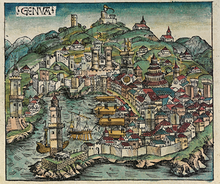
In the 15th century two of the earliest banks in the world were founded in Genoa: the
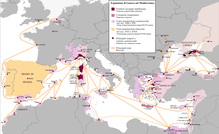
Thereafter, Genoa underwent something of an associate of the
17th and 18th centuries
From the 17th century, the Genoese Republic started a period of slow decline, In May 1625 a French-Savoian army briefly laid siege to Genoa. Though it was eventually
The Convention of Turin of 1742, in which Austria allied with the Kingdom of Sardinia, caused some consternation in the Republic. Consequently, the Republic of Genoa signed a secret treaty with the Bourbon allies of Kingdom of France, Spanish Empire and Kingdom of Naples. On 26 June 1745, the Republic of Genoa declared war on the Kingdom of Sardinia. This decision would prove disastrous for Genoa, which later surrendered to the Austrians in September 1746 and was briefly occupied before a revolt liberated the city two months later.[44]
In 1780, the Confetteria Romanengo was founded.[45]
In a much weaker state, Genoa was forced to cede Corsica to the French in the 1768 Treaty of Versailles.
The direct intervention of
Following the fall of Napoleon, Genoa regained ephemeral independence, with the name of the Repubblica genovese, which lasted less than a year. However, the Congress of Vienna established the annexation of the whole territories of the former Genoese Republic to the Kingdom of Sardinia, governed by the House of Savoy, contravening the principle of restoring the legitimate governments and monarchies of the old Republic.[47]
19th century
In the 19th century, Genoa consolidated its role as a major seaport and an important steel and shipbuilding centre. In Genoa in 1853,
20th century
In 1917
21st century
The 27th G8 summit, that took place in July 2001, was hosted in the city of Genoa; however, it was overshadowed by violent protests (Anti-globalisation movement), with one protester killed.[51] In 2003, the Istituto Italiano di Tecnologia (IIT) was established. In 2004, the European Union designated Genoa as the European Capital of Culture for that year, along with the French city of Lille.
In 2015, work began to secure the Genoa area, hit by the floods of 2010, 2011 and 2014, with the reconstruction and expansion of the coverage of the
In 2017, the architect Renzo Piano donated the design of the Levante Waterfront[54][55] to the Municipality of Genoa; this project involves a radical transformation of the Fiera di Genova, with the creation of a new dock and an urban park, the continuation of Corso Italia towards Porta Siberia and the construction of residential structures. In 2018, the first planning and study works began for the realization of the Waterfront of Levante project.[56]
From 21 April to 6 May 2018, Euroflora 2018 took place, an exhibition of flowers and ornamental plants for the first time in the Parchi di Nervi venue, rather than in the historic venue of the Fiera di Genova.
On 14 August 2018 the Ponte Morandi viaduct bridge for motor vehicles collapsed during a torrential downpour, leading to 43 deaths.[57] The remains of the Ponte Morandi viaduct bridge were demolished in August 2019. The replacement bridge, the Genoa-Saint George Bridge, was inaugurated in August 2020 during COVID-19 pandemic.
The tragedy of the collapse of the
Starting from 2021, the Mayor
From 23 April 2022 to 8 May 2022, Euroflora 2022 took place for the second time at the Nervi Parks.[61]
In 2023 Genoa becomes the finish of The Ocean Race.[62]
Flag

The flag of Genoa is a
The patron saint of Genoa was Saint
The saint's flag was the city's main war flag, but the cross flag was used alongside it in the 1240s.[64]
The Saint George's flag (i.e. the flag depicting the saint) remained the main flag of Genoa at least until the 1280s. The flag now known as the "St. George's Cross" seems to have replaced it as Genoa's main flag at some point during the 14th century. The Book of Knowledge of All Kingdoms (c. 1385) shows it, inscribed with the word iustiçia, and described as:
And the lord of this place has as his ensign a white pennant with a red cross. At the top it is inscribed with 'justice', in this manner.[65]
There was also a historiographical tradition claiming[66] that the flag of England was adopted from the Genoese flag during the Third Crusade in 1190; however, it cannot be substantiated as historical.[67]
Geography
The city of Genoa covers an area of 243 square kilometres (94 sq mi) between the
Genoa is adjacent to two popular Ligurian vacation spots: Camogli and Portofino. In the metropolitan area of Genoa lies Aveto Natural Regional Park.
Climate
Genoa has a Mediterranean climate (Csa) in the Köppen climate classification, with plentiful precipitation due to its location on a common storm track. Due to its position between the sea and mountains over 1000 meters high, each neighborhood of Genoa has specific climatic characteristics.
The average yearly temperature is around 20 °C (68 °F) during the day and 14 °C (57 °F) at night. In the coldest months, the average temperature is 12 °C (54 °F) during the day and 6 °C (43 °F) at night. In the warmest months – July and August – the average temperature is 28 °C (82 °F) during the day and 22 °C (72 °F) at night. The daily temperature range is limited, with an average range of about 6 °C (11 °F) between high and low temperatures. Genoa also sees significant moderation from the sea, in stark contrast to areas behind the Ligurian mountains such as Parma, where summers are hotter and winters are quite cold.
Annually, the average 2.9 of nights recorded temperatures of ≤0 °C (32 °F) (mainly in January). The coldest temperature ever recorded was −8 °C (18 °F) in February 2012; the highest temperature ever recorded during the day is 38.5 °C (101 °F) in August 2015. Average annual number of days with temperatures of ≥30 °C (86 °F) is about 8, four days in July and August.[68]
Average annual temperature of the sea is 17.5 °C (64 °F), from 13 °C (55 °F) in the period January–March to 25 °C (77 °F) in August. In the period from June to October, the average sea temperature exceeds 19 °C (66 °F).[69]
Genoa is also a windy city, especially during winter when northern winds often bring cool air from the Po Valley (usually accompanied by lower temperatures, high pressure and clear skies). Another typical wind blows from southeast, mostly as a consequence of Atlantic disturbances and storms, bringing humid and warmer air from the sea. Snowfall is sporadic, but does occur almost every year, albeit big amounts in the city centre are rare.[70][71] Genoa often receives heavy rainfall in autumn from strong convection. Even so, the overall number of precipitation days is quite modest. There are on average 11.57 days annually with thunder, which is more common from May to October than other times of the year.[72]
Annual average
Sunshine hours total above 2,200 per year, from an average 4 hours of sunshine duration per day in winter to average 9 hours in summer.
| Climate data for Genoa (1991–2020 normals), 2 m asl, sunshine 1971–2000, extremes since 1955 | |||||||||||||
|---|---|---|---|---|---|---|---|---|---|---|---|---|---|
| Month | Jan | Feb | Mar | Apr | May | Jun | Jul | Aug | Sep | Oct | Nov | Dec | Year |
| Record high °C (°F) | 20.3 (68.5) |
22.5 (72.5) |
25.0 (77.0) |
29.4 (84.9) |
32.8 (91.0) |
35.6 (96.1) |
35.4 (95.7) |
38.3 (100.9) |
34.2 (93.6) |
28.9 (84.0) |
22.9 (73.2) |
20.8 (69.4) |
38.3 (100.9) |
| Mean daily maximum °C (°F) | 12.1 (53.8) |
12.7 (54.9) |
15.2 (59.4) |
17.8 (64.0) |
21.5 (70.7) |
24.9 (76.8) |
27.8 (82.0) |
28.3 (82.9) |
25.0 (77.0) |
20.5 (68.9) |
16.1 (61.0) |
13.1 (55.6) |
19.6 (67.3) |
| Daily mean °C (°F) | 9.1 (48.4) |
9.6 (49.3) |
12.1 (53.8) |
14.6 (58.3) |
18.4 (65.1) |
22.0 (71.6) |
24.7 (76.5) |
25.1 (77.2) |
21.8 (71.2) |
17.6 (63.7) |
13.3 (55.9) |
10.1 (50.2) |
16.6 (61.9) |
| Mean daily minimum °C (°F) | 6.0 (42.8) |
6.5 (43.7) |
8.9 (48.0) |
11.3 (52.3) |
15.3 (59.5) |
19.0 (66.2) |
21.6 (70.9) |
21.8 (71.2) |
18.5 (65.3) |
14.7 (58.5) |
10.5 (50.9) |
7.1 (44.8) |
13.5 (56.3) |
| Record low °C (°F) | −8.5 (16.7) |
−5.0 (23.0) |
−3.6 (25.5) |
3.4 (38.1) |
6.6 (43.9) |
7.3 (45.1) |
13.9 (57.0) |
10.7 (51.3) |
9.0 (48.2) |
5.1 (41.2) |
1.1 (34.0) |
−3.6 (25.5) |
−8.5 (16.7) |
| Average precipitation mm (inches) | 76.4 (3.01) |
57.9 (2.28) |
73.8 (2.91) |
83.6 (3.29) |
57.8 (2.28) |
51.2 (2.02) |
26.2 (1.03) |
47.6 (1.87) |
115.9 (4.56) |
149.7 (5.89) |
200.2 (7.88) |
99.4 (3.91) |
1,039.7 (40.93) |
| Average precipitation days (≥ 1 mm) | 5.9 | 5.0 | 5.3 | 7.0 | 5.8 | 4.4 | 3.0 | 3.7 | 5.5 | 7.4 | 8.8 | 6.9 | 68.7 |
| Average dew point °C (°F) | 1.8 (35.2) |
2.5 (36.5) |
5.1 (41.2) |
8.5 (47.3) |
12.6 (54.7) |
16.4 (61.5) |
18.7 (65.7) |
18.7 (65.7) |
14.5 (58.1) |
11.4 (52.5) |
6.7 (44.1) |
2.8 (37.0) |
10.0 (50.0) |
| Mean monthly sunshine hours | 117.8 | 130.5 | 158.1 | 192.0 | 220.1 | 246.0 | 294.5 | 266.6 | 201.0 | 173.6 | 111.0 | 111.6 | 2,222.8 |
| Source 1: Météo Climat[73] | |||||||||||||
| Source 2: Servizio Meteorologico,[68] data of sunshine hours,[74] NOAA (Dew point for Sestri[72]) | |||||||||||||
Government
Municipal government
The Municipal Council of Genoa is currently led by a right-wing majority, elected in June 2017. The mayor is Marco Bucci, expression of a right-wing alliance composed by Forza Italia, Lega Nord, Fratelli d'Italia and other minor lists. Genoa was traditionally considered a leftist city and Bucci is the first right-wing mayor since 1975.
Administrative subdivision
The city of Genoa is subdivided into nine municipi (administrative districts), as approved by the Municipal Council in 2007.[75]
| Municipio | Population (% of total) | Quartieri
|
|---|---|---|
| Centro-Est | 91,402 (15.0%) | Prè, Molo, Maddalena, Oregina, Lagaccio, San Nicola, Castelletto, Manin, San Vincenzo, Carignano |
| Centro-Ovest | 66,626 (10.9%) | Sampierdarena, Belvedere, Campasso, San Bartolomeo, San Teodoro, Angeli |
| Bassa Val Bisagno | 78,791 (12.9%) | San Fruttuoso, Sant'Agata, Marassi, Quezzi, Fereggiano, Forte Quezzi |
| Media Val Bisagno | 58,742 (9.6%) | Staglieno (Parenzo, San Pantaleo), Molassana, Sant'Eusebio, Montesignano, Struppa (Doria, Prato) |
| Valpolcevera | 62,492 (10.3%) | Rivarolo, Borzoli Est, Certosa, Teglia, Begato, Bolzaneto, Morego, San Quirico, Pontedecimo |
| Medio Ponente | 61,810 (10.1%) | Sestri, Borzoli Ovest, San Giovanni Battista, Cornigliano, Campi, Calcinara, |
| Ponente | 63,027 (10.3%) | Voltri, Crevari, Pra', Palmaro, Ca' Nuova, Pegli, Multedo, Castelluccio |
| Medio Levante | 61,759 (10.1%) | Foce, Brignole, San Martino, Chiappeto, Albaro, San Giuliano, Lido, Puggia |
| Levante | 66,155 (10.8%) | Sturla, Quarto, Quartara, Castagna, Quinto al Mare, Nervi, Apparizione, Borgoratti, San Desiderio, Bavari, Sant'Ilario |
Cityscape
Main sights
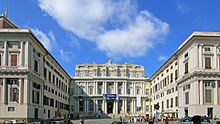
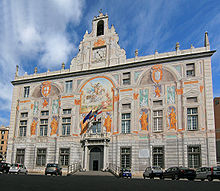
Notable to the city are the
Genoa's historic centre is articulated in a maze of squares and narrow caruggi (typical Genoese alleys). It joins a
Near
The symbols of the city are the
Another tourist destination is the ancient seaside district of Boccadasse (which means "the mouth of the donkey"), with its multicolour boats, set as a seal to Corso Italia, the promenade which runs along the Lido d'Albaro, and known for its ice-creams. After Boccadasse you can continue along the sea up to Sturla.


Just out of the city centre, but still part of the 33 km (21 mi) of coast included in the municipality's territory, are Nervi, natural doorway to the Ligurian East Riviera, and Pegli, the point of access to the West Riviera. Nervi offers many attractions: the promenade overlooking the sea called Passeggiata Anita Garibaldi; parks covered with lush tropical vegetation; numerous villas and palaces open to the public that now house museums (like GAM-Galleria d'Arte Moderna, Raccolte Frugone Museum, Museo Giannettino Luxoro and Wolfsoniana). (see also Parchi di Nervi) The East Riviera of Genoa called Riviera di Levante is part of the Italian Riviera. East Riviera is full of interesting towns to visit, and then from Genoa to east are: Bogliasco, Pieve Ligure, Sori, Recco, Camogli, Portofino, Santa Margherita Ligure, Rapallo, Zoagli, Chiavari, Lavagna and Sestri Levante. In the west, Pegli is the site of the famous Villa Durazzo-Pallavicini and Arenzano is a seaside town at the foot of the Parco naturale regionale del Beigua.
The new Genoa based its rebirth upon the restoration of the green areas of the immediate inland parts, among them the Parco naturale regionale del Beigua, and upon the construction of facilities such as the Aquarium of Genoa in the Old Harbour – the biggest in Italy and one of the major in Europe – and its Marina (the tourist small port which holds hundreds of pleasure boats). All of these are inside the restored Expo Area, arranged in occasion of the Columbian Celebrations of 1992.
Near the city are
The regained pride gave back to the city the consciousness of being capable of looking to the future without forgetting its past. The resumption of several flourishing hand-crafting activities, far-back absent from the caruggi of the old town, is a direct evidence of it. The restoration of many of Genoa's churches and palaces in the 1980s and the 1990s contributed to the city's rebirth. A notable example the
Genoa could not renounce, especially from the 1960s, to a great renewal, which as happened in several other metropolis, should necessarily get through the realisation of big public housing complexes, whose quality, utility and functionality has been and still is controversial for those residents living there.[
Beyond a complete restyling of the area, the ancient port zone nearby the Mandraccio opening, in Porta Siberia, was enriched by Genoese architect
Nearby the Old Harbour is the so-called "
Churches
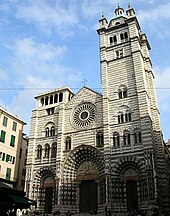

Another well known Genoese church is the shrine of Saint Francis of Paola, notable for the outer courtyard overlooking the port and the memorial to all those who died at sea. This church is of artistic mention in that the tile depictions of the Via Crucis Stations along the brick path to the church.
Near Genoa is found the Shrine of Nostra Signora della Guardia, (the sanctuary is said to have inspired the writer Umberto Eco in making his novel The Name of the Rose). Another interesting church in the neighborhoods of Genoa is San Siro di Struppa.
The city was the birthplace of several popes (
Buildings and palaces
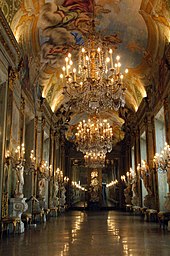
The main features of central Genoa include the
In the old port area called

Of the many palaces built by the nobility in the city center of Genoa, 114 have not been substantially altered (see also
The Genoese Renaissance began with the construction of Villa del Principe commissioned by Andrea Doria: the architects were Giovanni Angelo Montorsoli and Giovanni Ponzello, the interior was painted by Perino del Vaga and the garden fountain was realised by Taddeo Carlone.[79]
In 1548
Scattered around the city are many villas, built between the fifteenth and the twentieth centuries. Among the best known are:

As it regards the 19th century remember the architects Ignazio Gardella (senior), and Carlo Barabino which among other things, realises together with Giovanni Battista Resasco, the Monumental Cemetery of Staglieno. The cemetery is renowned for its statues and sepulchral monuments that preserve the mortal remains of notable personalities, including Giuseppe Mazzini, Fabrizio De André, and Constance Lloyd (Oscar Wilde's wife). In the first half of the 19th century they are completed the Albergo dei Poveri and the Acquedotto storico. In 1901 Giovanni Antonio Porcheddu realised the Silos Granari.

The city is rich in testimony of the
Other notable architectural works include: the Old Harbour's new design with the Aquarium, the Bigo and the Biosfera by Renzo Piano, the Palasport di Genova, the Matitone skyscraper, and the Padiglione B of Genoa Fair, by Jean Nouvel. Genoa was home to the Ponte Morandi by Riccardo Morandi, built in 1967, collapsed in 2018 and demolished February–June 2019.[80]
Old Harbour

The Old Harbour ("Porto Antico" in Italian) is the ancient part of the port of Genoa. The harbour gave access to outside communities creating a good geographical situation for the city.
As the Genoa harbour was so important to the merchants for their own economic success, other nearby harbours and ports were seen as competition for a landing point for foreign traders. In the 16th century, the Genovese worked to destroy the local shipping competition, the Savona harbour.[46] Taking matters into their own hands, the Genoa merchants and the politically powerful in Genoa attacked the harbour of Savona with stones.[46] This action was taken to preserve the economic stability and wealth of the city during the rise in prominence of Savona. The Genovese would go as far as to war with other coastal, trading cities such as Venice,[46] to protect the trade industry.
Renzo Piano redeveloped the area for public access, restoring the historical buildings (like the Cotton warehouses) and creating new landmarks like the Aquarium, the Bigo and recently the "Bolla" (the Sphere). The main touristic attractions of this area are the famous Aquarium and the Museum of the Sea (MuMA). In 2007 these attracted almost 1.7 million visitors.[82]
Walls and fortresses

The city of Genoa during its long history at least since the ninth century had been protected by different lines of
Parks

Genoa has 82,000 square metres (880,000 square feet) of public parks in the city centre, such as Villetta Di Negro which is right in the heart of the town, overlooking the historical centre. Many bigger green spaces are situated outside the centre: in the east are the Parks of
The city is surrounded by natural parks such as
Aquarium of Genoa
The Aquarium of Genoa (in Italian: Acquario di Genova) is the largest aquarium in Italy and among the largest in Europe. Built for Genoa Expo '92, it is an educational, scientific and cultural centre. Its mission is to educate and raise public awareness as regards conservation, management and responsible use of aquatic environments. It welcomes over 1.2 million visitors a year.
Control of the entire environment, including the temperature, filtration and lighting of the tanks was provided by local Automation Supplier Orsi Automazione, acquired in 2001 by Siemens. The Aquarium of Genoa is co-ordinating the AquaRing EU project. It also provides scientific expertise and a great deal of content for AquaRing, including documents, images, academic content and interactive online courses, via its Online Resource Centre.[84]
Demographics
| Year | Pop. | ±% |
|---|---|---|
| 1115 | 50,000 | — |
| 1300 | 100,000 | +100.0% |
| 1400 | 100,000 | +0.0% |
| 1400+ | 117,000 | +17.0% |
| 1861 | 242,447 | +107.2% |
| 1871 | 256,486 | +5.8% |
| 1881 | 289,234 | +12.8% |
| 1901 | 377,610 | +30.6% |
| 1911 | 465,496 | +23.3% |
| 1921 | 541,562 | +16.3% |
| 1931 | 590,736 | +9.1% |
| 1936 | 634,646 | +7.4% |
| 1951 | 688,447 | +8.5% |
| 1961 | 784,194 | +13.9% |
| 1971 | 816,872 | +4.2% |
| 1981 | 762,895 | −6.6% |
| 1991 | 678,771 | −11.0% |
| 2001 | 610,307 | −10.1% |
| 2011 | 608,493 | −0.3% |
| 2015 | 588,668 | −3.3% |
| 2021 | 562,637 | −4.4% |
| Source: | ||
At the beginning of 2011, there were 608,493 people residing in Genoa, of whom 47% were male and 53% were female. The city is characterised by rapid aging and a long history of demographic decline, that has shown a partial slowdown in the last decade. Genoa has the lowest birth rate and is the most aged of any large Italian city. Minors (children ages 18 and younger) totalled only 14.12% of the population compared to pensioners who number 26.67%. This compares with the Italian average of 18.06% (minors) and 19.94% (pensioners). The median age of Genoa's residents is 47, compared to the Italian average of 42. The current birth rate of the city is only 7.49 births per 1,000 inhabitants, compared to the national average of 9.45.
Economy
The Genoa metropolitan area had a GDP amounting to $30.1 billion in 2011, or $33,003 per capita.[88]
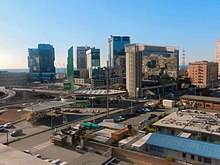

Ligurian agriculture has increased its specialisation pattern in high-quality products (flowers, wine, olive oil) and has thus managed to maintain the gross value-added per worker at a level much higher than the national average (the difference was about 42% in 1999).[89] The value of flower production represents over 75% of the agriculture sector turnover, followed by animal farming (11.2%) and vegetable growing (6.4%).
Steel, once a major industry during the booming 1950s and 1960s, phased out after the late 1980s crisis, as Italy moved away from the heavy industry to pursue more technologically advanced and less polluting productions. So the Ligurian industry has turned towards a widely diversified range of high-quality and high-tech products (food, shipbuilding (in Sestri Ponente and in metropolitan area – Sestri Levante), electrical engineering and electronics, petrochemicals, aerospace etc.). Nonetheless, the regions still maintains a flourishing shipbuilding sector (yacht construction and maintenance, cruise liner building, military shipyards).[89]
In the services sector, the gross value-added per worker in Liguria is 4% above the national average. This is due to the increasing diffusion of modern technologies, particularly in commerce and tourism.
A good motorway network (376 km (234 mi) in 2000) makes communications with the border regions relatively easy. The main motorway is located along the coastline, connecting the main ports of Nice (in France), Savona, Genoa and La Spezia. The number of passenger cars per 1000 inhabitants (524 in 2001) is below the national average (584).
On average, about 17 million tonnes of cargo are shipped from the main ports of the region and about 57 million tonnes enter the region.
Some big companies based in Genoa include
.Education

The first organised forms of higher education in Genoa date back to the 13th century when private colleges were entitled to award degrees in medicine, philosophy, Theology, Law, Arts.[93] Today the University of Genoa, founded in the 15th century, is one of the largest in Italy, with 11 faculties, 51 departments and 14 libraries. In 2007–2008, the university had 41,000 students and 6,540 graduates.[94]
Genoa is also home to other Colleges, Academies or Museums:
- The University of Genoa
- The CNR Area della Ricerca di Genova
- The Accademia ligustica di belle arti
- The Accademia Ligure di scienze e lettere
- The Istituto Italiano di Tecnologia
- The ISICT-istituto superiore di studi in tecnologie dell'informazione e della comunicazione
- The Renzo Piano Building Workshop
- The OBR Open Building Research
- The Accademia Italiana della Marina Mercantile
- The "Niccolò Paganini" Conservatory
- The Italian Hydrographic Institute
- The Deledda International School
- The Deutsche Schule Genua
- The Genoa Comics Academy
- The International School in Genoa
- The Russian BalletCollege
The
Clemson University, based in South Carolina, United States has a villa in Genoa where architecture students and students in related fields can attend for a semester or year-long study program.
Florida International University (FIU), based in Miami, Florida, United States also has a small campus in Genoa, with the University of Genoa, which offers classes within the FIU School of Architecture.
Science

Genoa is the birthplace of
In 1846 the city hosted the eighth Meeting of Italian Scientists and in 1902 Luigi Carnera discovered an asteroid and called it "485 Genua", dedicating it to the Latin name of Genoa.
Erzelli science technology park
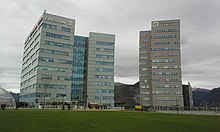
The western area of Genoa hosts the
Transport
Ports
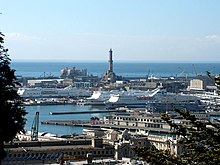
Several cruise and ferry lines serve the passenger terminals in the old port, with a traffic of 3.2 million passengers in 2007.[99] MSC Cruises chose Genoa as one of its main home ports, in competition with the Genoese company Costa Cruises, which moved its home port to Savona. The quays of the passenger terminals extend over an area of 250,000 square metres (2,700,000 square feet), with 5 equipped berths for cruise vessels and 13 for ferries, for an annual capacity of 4 million ferry passengers, 1.5 million cars and 250,000 trucks.[100]
The historical maritime station of Ponte dei Mille is today a technologically advanced cruise terminal, with facilities designed after the world's most modern airports, to ensure fast embarking and disembarking of latest generation ships carrying thousand passengers. A third cruise terminal is currently under construction in the redesigned area of Ponte Parodi, once a quay used for grain traffic.
The Costa Concordia cruise ship, owned by Costa Cruises, was docked at the port before being dismantled.[101]
Air transport

The Airport of Genoa (IATA: GOA, ICAO: LIMJ) (Italian: Aeroporto di Genova) also named Christopher Columbus Airport (Italian: Aeroporto Cristoforo Colombo) is built on an artificial peninsula, 4 NM (7.4 km; 4.6 mi) west[102] of the city. The airport is currently operated by Aeroporto di Genova S.P.A., which has recently upgraded the airport complex, that now connects Genoa with several daily flights to Rome, Naples, Paris, London, Madrid and Munich. In 2008, 1,202,168 passengers travelled through the airport,[103] with an increase of international destinations and charter flights.
Public transport
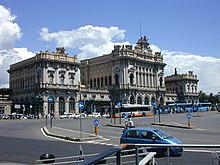
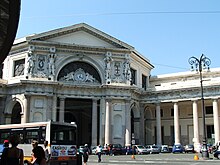
The main railway stations are Genoa Brignole in the east and Genoa Principe in the west. Genoa Brignole is close to the business districts and the exhibition centre, while the Principe is close to the port, the university and the historical centre. From these two stations depart the main trains connecting Genoa to France, Turin, Milan and Rome.
Genoa's third most important station is Genoa Sampierdarena, which serves the densely populated neighbourhood of Sampierdarena. 23 other local stations serve the other neighbourhoods on the 30-kilometre-long coast line from Nervi to Voltri and on the northern line through Bolzaneto and the Polcevera Valley.
The municipal administration of Genoa plans to transform these urban railway lines to be part of the rapid transit system, which now consists of the Metropolitana di Genova (
The city's hilly nature has influenced its public transport. The city is served by two
The city's metro, bus and
Culture
Visual arts
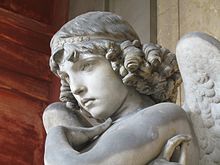
Genoese painters active in the 14th century include Barnaba da Modena and his local followers Nicolò da Voltri and at the same time, the sculptor Giovanni Pisano reached Genoa to make the monument for Margaret of Brabant, whose remains are today housed in the Museum of Sant'Agostino.
In the 16th century along with the flourishing trade between the Republic of Genoa and Flanders also grew the cultural exchanges. The painters Lucas and Cornelis de Wael lived in Genoa for a long time, where they played the role of a magnet for many Flemish painters like Jaan Roos, Giacomo Legi, Jan Matsys, Andries van Eertvelt and Vincent Malo.
This creative environment also attracted the two most important Flemish painters,
Much of the city's art is found in its churches and palaces, where there are numerous Renaissance, Baroque and Rococo frescos. They are rich in works of art the
.The most important Genoese painters are:
The famous humanist author, architect, poet and philosopher
Genoa is also famous for its numerous tapestries, which decorated the city's many salons. Whilst the patrician palaces and villas in the city were and still are austere and majestic, the interiors tended to be luxurious and elaborate, often full of tapestries, many of which were Flemish.[110] Famous is the Genoese lace called with its name of Turkish origin macramè. Very used in Genoa is the cobblestone called Risseu and a kind of azulejo called laggioni.
Genoa has been likened by many to a Mediterranean New York, perhaps for its high houses that in the Middle Ages were the equivalent of today's skyscrapers, perhaps for the sea route Genoa-New York which in past centuries has been travelled by millions of emigrants. The architect Renzo Picasso in his visionary designs reinforces this strange affinity between the two cities.
In the Monumental Cemetery of Staglieno, you can admire some magnificent sculpture of the 19th century and early 20th century like Monteverde Angel by Giulio Monteverde, or works by artists such as Augusto Rivalta, Leonardo Bistolfi, Edoardo Alfieri, Santo Varni.
Amongst the most notable Genoese painters of the 19th century and of the first half of the 20th century are Tammar Luxoro, Ernesto Rayper, Rubaldo Merello, and Antonio Giuseppe Santagata. The sculptor Francesco Messina also grew up in Genoa.
In 1967 the Genoese historian, critic and curator Germano Celant coined the term Arte Povera. Enrico Accatino was another important art theorist and Emanuele Luzzati was the production designer and illustrator like Lorenzo Mongiardino, also a production designer and architect. Two other important artists are Emilio Scanavino and Vanessa Beecroft.
The yearly International Cartoonists Exhibition was founded in 1972 in Rapallo, near Genoa. A notable figure is the illustrator and comics artist Giovan Battista Carpi.
Literature
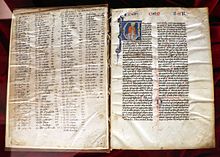
"Anonymous of Genoa" was one of the first authors in Liguria and Italy who wrote verses in the Vernacular. It explained that in Genoa Marco Polo and Rustichello da Pisa, in the prisons of Palazzo San Giorgio, wrote The Travels of Marco Polo. The Golden Legend is a collection of hagiographies written by the Archbishop of Genoa Jacobus de Voragine. To animate the Genoese literary environment of the 16th century were Gabriello Chiabrera and "Ansaldo Cebà", the latter best known for his correspondence with Sara Copia Sullam. The city has been the birthplace of the historian Caffaro di Rustico da Caschifellone, of the poet "Martin Piaggio", of the famous historian, philosopher and journalist Giuseppe Mazzini, of the writer Piero Jahier, of the poet Nobel Prize Eugenio Montale. The writer and translator Fernanda Pivano, the journalist "Vito Elio Petrucci" and the poet Edoardo Sanguineti, the literary critic Carlo Bo instead was born in Sestri Levante near Genoa. We have also remember the dialet poet Edoardo Firpo, the dialect "poeta crepuscolare" Giambattista Vigo, and the symbolist Ceccardo Roccatagliata Ceccardi.
The city of Genoa has been an inspiration to many writers and poets among which: Dino Campana, Camillo Sbarbaro, Gaspare Invrea who wrote "The mouth of the wolf" and Giorgio Caproni. Between the alleys of the historical centre there is the Old Libreria Bozzi. The "Berio Civic Library" houses the precious manuscript entitled "The Durazzo Book of Hours". In the first half of the 20th century, the Mazzini Gallery's was a meeting place of many artists, writers and intellectuals among which Guido Gozzano, Salvatore Quasimodo, Camillo Sbarbaro, Francesco Messina, Pierangelo Baratono, Eugenio Montale. In the thirties of the 20th century was active in Genoa the Circoli magazine and after the World War II the "Il Gallo" magazine. Coveted and known from the 1960s to the 1980s was the Genoese literary lounge animated by the writer Minnie Alzona. Dutch writer Ilja Leonard Pfeijffer wrote "La Superba", a novel in which Genoa is prominently featured. This was followed by the autobiographical novel "Brieven uit Genua".
Since 1995, every June in Genoa the Genoa International Poetry Festival takes place, conceived by Claudio Pozzani with the help of Massimo Bacigalupo.
Music
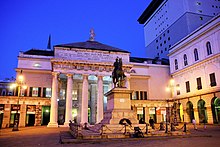
Genoa was a centre of Occitan culture in Italy and for this reason it developed an important school of troubadours: Lanfranc Cigala, Jacme Grils, Bonifaci Calvo, Luchetto Gattilusio, Guillelma de Rosers, and Simon Doria.
Genoa is the birthplace of the composer
Alessandro Stradella, a composer of the middle baroque, lived in Genoa and was assassinated in 1682.
Felice Romani was a poet who wrote many librettos for the opera composers like Gaetano Donizetti and Vincenzo Bellini. Giovanni Ruffini was another poet known for writing the libretto of the opera Don Pasquale for its composer.
In 1847, Goffredo Mameli and Michele Novaro composed "Il Canto degli Italiani".
In 1857, debuted the work of Giuseppe Verdi entitled Simon Boccanegra inspired by the first Doge of Genoa, Simone Boccanegra.
Genoa is also the birthplace of the condcuctor Fabio Luisi and of many opera singers like Giuseppe Taddei, Margherita Carosio, Luciana Serra, Ottavio Garaventa, Luisa Maragliano and Daniela Dessì.
The oldest theatre in Genoa was the Teatro del Falcone. Active since the 16th century, it was the second public theatre in Italy, only preceded by the one in the Republic of Venice.[112] It was followed by the Teatro delle Vigne which, however, along with other important theaters in the city (Teatro Margherita, Teatro Paganini, Teatro Colombo), was demolished between the 19th and 20th centuries, either to make way for urban expansion or due to damage caused by bombing of Genoa during World War II.
The Teatro Carlo Felice, the main opera theatre in the city, was built in 1828 in the Piazza De Ferrari, and named for the monarch of the then Kingdom of Sardinia (which included the present regions of Sardinia, Piedmont and Liguria). The theatre was the centre of music and social life in the 19th century. On various occasions in the history of the theatre, presentations have been conducted by Mascagni, Richard Strauss, Hindemith and Stravinsky. Other prominente Genoese theaters are the Teatro Nazionale di Genoa, Politeama Genovese, Teatro di Sant'Agostino and Teatro Gustavo Modena.
On the occasion of the Christopher Columbus celebration in 1992, new musical life was given to the area around the old port, including the restoration of the house of Paganini and presentations of the trallalero, the traditional singing of Genoese dock workers.
The trallalero, traditional music in the Genoese dialect, is a
The singer Natalino Otto started the swing genre in Italy and his friend and colleague Pippo Barzizza was a composer, arranger, conductor and music director. Other musicians, composers and arrangers are Angelo Francesco Lavagnino, Gian Piero Reverberi, Gian Franco Reverberi, Oscar Prudente, Pivio and Aldo De Scalzi.
Genoa in the second half of the 20th century was famous for an important school of Italian singer-songwriters, so-called
Some songs about the city of Genoa are part of Italian popular culture, like "
I Madrigalisti di Genova is a vocal and instrumental group formed in 1958 which specialised in medieval and Renaissance repertoire
The city has numerous music festivals, among which are Concerts at
Giovine Orchestra Genovese, one of the oldest concert societies in Italy, was founded in Genoa in 1912.
Cinema
Genoa has been the set for many films and especially for the genre called Polizieschi. Notable directors born in Genoa include Pietro Germi and Giuliano Montaldo, the actors: Gilberto Govi, Vittorio Gassman, Paolo Villaggio, Alberto Lupo, the actresses: Lina Volonghi, Delia Boccardo, Rosanna Schiaffino, Eleonora Rossi Drago, Marcella Michelangeli and the pornographic actress Moana Pozzi. Before actor Bartolomeo Pagano's cinema career, he was a camallo, which means stevedore, at the port of Genoa. His cinema career began with the film Cabiria, one of the first and most famous kolossal. In 1985 were filmed in Genoa some scenes of Pirates by Roman Polanski, finished shooting they left in the Old Harbour the galleon Neptune.
Some films set in Genoa:
- Agata and the Storm
- Amore che vieni, amore che vai, from the novel Un destino ridicolo
- Attention! Bandits!
- Behind Closed Shutters
- The Blue-Eyed Bandit
- Carlo Giuliani, Boy
- The Case of the Bloody Iris
- The Conspiracy in Genoa
- Days and Clouds
- Di che segno sei?
- Diaz - Don't Clean Up This Blood
- Father and Son
- General Della Rovere
- Genova
- High Crime
- In the Beginning There Was Underwear
- The Magistrate
- Mare Matto
- Mark Shoots First
- Mean Frank and Crazy Tony
- Merciless Man
- The Mouth of the Wolf
- Onde
- The Police Serve the Citizens?
- Processo contro ignoti
- Scent of a Woman
- Street Law
- Stregati
- The Walls of Malapaga
- The Yellow Rolls-Royce
Language
The Genoese dialect (Zeneize) is the most important dialect of the
Sports

There are two major football teams in Genoa:
The international tennis tournament AON Open Challenger takes place in Genoa.
In rugby union the city is represented by CUS Genova Rugby, which is the rugby union team of the University of Genoa Sports Centre. CUS Genova had their peak in 1971–1973 when the team was runner-up of the Italian Serie A for three consecutive seasons and contested unsuccessfully the title to Petrarca Rugby. Amongst the CUS Genova players who represented Italy at international level the most relevant were Marco Bollesan and Agostino Puppo.
In 1947 was founded the CUS Genova Hockey and in 1968 the basketball club Athletic Genova. The city hosted the FIFA World Cup in 1934 and 1990, in 1988 the European Karate Championships and in 1992 the European Athletics Indoor Championships. In 2003 the indoor sporting arena, Vaillant Palace, was inaugurated.
The city lends its name to a particular type of a sailing boat so-called
Cuisine
This section may need to be rewritten to comply with Wikipedia's quality standards. (September 2017) |

Popular sauces of Genoese cuisine include
Key ingredient of Genoese cuisine is the
.Other elements of Genoese cuisine include the Ligurian Olive Oil, the cheeses like
Two sophisticated recipes of Genoese cuisine are: the Cappon magro and the Cima alla genovese (a song by Fabrizio De André is titled 'A Çimma and is dedicated to this Genoese recipe). Originating in Genoa is Pandolce that gave rise to Genoa cake. The city lands its name to a special paste used to prepare cakes and pastries called Genoise and to the Pain de Gênes.
In Genoa there are many food markets in typical nineteenth-century iron structures as Mercato del Ferro, Mercato Dinegro, Mercato di Via Prè, Mercato di piazza Sarzano, Mercato del Carmine, Mercato della Foce, Mercato Romagnosi. The Mercato Orientale instead is in masonry and has a circular structure.
People
This section needs additional citations for verification. (February 2018) |

Genoa has left an extraordinary impression on many noted personalities. Friedrich Nietzsche loved Genoa and wrote some of his works there. Sigmund Freud and Ezra Pound lived near Genoa in Rapallo. Anton Chekhov said that Genoa "is the most beautiful city in the world," and Richard Wagner wrote: "I have never seen anything like this Genoa! it is something indescribably beautiful".
Among the personalities of the 19th and 20th centuries who wrote about Genoa were
Famous Genoese include: Sinibaldo and Ottobuono Fieschi (Popes
Some reports say the navigator and explorer Giovanni Caboto (
. Among the latest generations, musicians like Andrea Bacchetti, Giulio Plotino, Sergio Ciomei, Lorenzo Cavasanti, Stefano Bagliano and Fabrizio Cipriani, as well as academics and authors like Michele Giugliano and Roberto Dillon, help in keeping the name of the city on the international spotlight in different fields among the arts, technology and culture.Museums
- Accademia Ligustica di Belle Arti
- Albertis Castle
- Doge's Palace, Genoa
- Edoardo Chiossone Museum of Oriental Art
- Galata - Museo del mare
- Galleria d'arte moderna (GAM)
- Lighthouse of Genoa
- Mackenzie Castle
- Museo Civico di Storia Naturale di Genova
- Museo diocesano
- Museo di Santa Maria di Castello
- Museo Giannettino Luxoro
- Museum of Contemporary Art Villa Croce
- Museo del Risorgimento e istituto mazziniano
- Museum of Sant'Agostino
- Museo navale di Pegli
- Palazzo Bianco
- Palazzo Reale
- Palazzo Rosso
- Palazzi dei Rolli
- Palazzo Spinola di Pellicceria
- Via del Campo 29 rosso
- Raccolte Frugone
- Villa Durazzo-Pallavicini
- Wolfsoniana
Promenades

Corso Italia runs for 2.5 km (1.6 mi) in the quartiere of Albaro, linking two neighbourhoods of Foce and Boccadasse. The promenade, which was built in 1908, overlooks the sea, towards the promontory of Portofino. The main landmarks are the small lighthouse of Punta Vagno, the San Giuliano Abbey, and the Lido of Albaro.
Passeggiata Anita Garibaldi, promenade overlooking the sea and 2 kilometres (1.2 miles) long, Nervi.
Promenade of the upper ring road, so-called "Circonvallazione a Monte" that includes: Corso Firenze, Corso Paganini, Corso Magenta, Via Solferino, Corso Armellini.
Walks can be made from the centre of Genoa following one of the many ancient paths between tall palaces and the "Creuze" to reach the higher areas of the city where there are magnificent places like Belvedere Castelletto, the "Righi's district", the "Santuario di Nostra Signora di Loreto", the "Santuario della Madonnetta", the "Santuario di San Francesco da Paola".
Monte Fasce gives a complete view of the city.
To reach the hinterland of the Province of Genoa one can use the Genoa – Casella Old Railway, 25 kilometres (16 miles) of railway between the Genoese mountains.
International relations
Twin towns – sister cities
Genoa is twinned with:[118][119]
Cooperation agreements
As of 2013, Genoa had bilateral agreements with:[120]
- Acqui Terme, Italy
- Athens, Greece
- Azuchi, Japan
- Barcelona, Spain
- Belém, Brazil
- Bogotá, Colombia
- Buenos Aires, Argentina
- Capo di Ponte, Italy
- Castelsardo, Italy
- Constanța, Romania
- Cremona, Italy
- Dalian, China
- Deva, Romania
- Guayaquil, Ecuador
- Havana, Cuba
- Kaolack, Senegal
- Kyiv, Ukraine
- Latakia, Syria
- Lille, France
- Lyon, France
- Mantua, Italy
- El Mina, Lebanon
- Moscow, Russia
- Nice, France
- Ovada, Italy
- La Paz, Bolivia
- Pizzo Calabro, Italy
- Pointe-Noire, Congo
- Polokwane, South Africa
- Saint Petersburg, Russia
- Santo Domingo, Dominican Republic
- Siena, Italy
- Sousse, Tunisia
- Sumqayıt, Azerbaijan[121]
- Turin, Italy
- Tursi, Italy
- Valparaíso, Chile
- Varna, Bulgaria
- Yekaterinburg, Russia
Consulates
- Albania
- Austria
- Belgium
- Bangladesh
- Brazil
- Chile
- Colombia
- Costa Rica
- Cyprus
- Czech Republic
- Denmark
- Dominican Republic
- Ecuador
- El Salvador
- Estonia
- Finland
- France
- Germany
- Greece
- Guinea
- Haiti
- Hungary
- Kazakhstan
- Latvia
- Lithuania
- Luxembourg
- Malta
- Monaco
- Netherlands
- Norway
- Panama
- Peru
- Poland
- Portugal
- Republic of the Congo
- Romania
- Russia
- San Marino
- Senegal
- South Africa
- South Korea
- Spain
- Sweden
- Switzerland
- Thailand
- Tunisia
- Turkey
- Uganda
- United Kingdom
- United States
- Uruguay
Notable people
See also
Notes
References
- ^ "Superficie di Comuni Province e Regioni italiane al 9 ottobre 2011". Italian National Institute of Statistics. Retrieved 16 March 2019.
- ^ "Popolazione Residente al 1° Gennaio 2018". Italian National Institute of Statistics. Retrieved 16 March 2019.
- ^ a b "Bilancio demografico mensile". demo.istat.it. Retrieved 28 April 2023.
- ^ "Urbanismi, Cluster urbani e aree metropolitane – volume primo, Italia" (PDF) (in Italian). Archived from the original (PDF) on 6 October 2014. Retrieved 23 February 2013.
- ^ "Genoa". Encyclopædia Britannica. Encyclopædia Britannica, inc. Retrieved 24 March 2017.
- ^ "Maritime ports freight and passenger statistics". Eurostat. Retrieved 24 March 2017.
- ^ "Genoa: a bloody history, a beguiling present | Italy". London: Times Online. 25 April 2004. Retrieved 11 April 2009.
- ^ "This City Once Ruled the Mediterranean. Now It's Eyeing a Comeback". Bloomberg.com. 19 February 2019. Retrieved 15 November 2020.
- ^ "Genoa | Geography, History, Facts, & Points of Interest". Encyclopedia Britannica. Retrieved 11 December 2020.
- ^ "Genova "la Superba": l'origine del soprannome". GenovaToday (in Italian). Retrieved 11 December 2020.
- ISBN 978-0-275-96777-2.
- ^ Alta Macadam, Northern Italy: From the Alps to Bologna, Blue Guides, 10th edn. (London: A. & C. Black, 1997).
- ^ "Centro storico di Genova, caruggi, città vecchia, vicoli, Genova di de André | Visitgenoa.it Historic centre". www.visitgenoa.it. Retrieved 17 August 2020.
- ISBN 9781843530602, retrieved 22 October 2021
- ^ 'Genoa Economy' Archived 13 June 2010 at the Wayback Machine, World66.com.
- ^ 'Italy: Industry', Encyclopedia of the Nations, Advameg, Inc.
- ^ "Selex ES: Company profile". LinkedIn Corporation. Archived from the original on 27 November 2013.
- ^ "Ansaldo Energia: Company profile". LinkedIn Corporation. Archived from the original on 12 December 2013.
- ^ Petracco Sicardi, Giulia. Toponomastica storica della Liguria (in Italian). SAGEP.
- ^ Melli, Piera. Genova preromana. Città portuale del Mediterraneo tra il VII e il III secolo a.C. (in Italian). Frilli (2007).
- ^ "Archeologia Metropolitana Museo di Archeologia Ligure Genova". 1995-2015.undo.net (in Italian). Retrieved 11 December 2020.
- ^ The objects found during the works for the underground had been exposed in the exhibition Archeologia Metropolitana. Piazza Brignole e Acquasola, held at the Ligurian Archeology Museum (30 November 2009 – 14 February 2010) ([1] Archived 30 December 2013 at the Wayback Machine)
- ^ Melli, Piera. Genova preromana. Città portuale del Mediterraneo tra il VII e il III secolo a.C. (in Italian). Frilli.
- ^ "I Liguri – L'Oltre Po". www.robertomarchese.it. Retrieved 30 January 2022.
- ^ "Alla scoperta di Genova: Genova romana". danielea.altervista.org. Retrieved 27 December 2021.
- ^ Paul the Deacon, Historia Langobardorum, II.25
- ^ Steven A. Epstein (2002). Genoa and the Genoese, 958–1528. The University of North Carolina Press. p. 14.
- ^ ISBN 0-8078-4992-8.
- ^ ISBN 0-299-80926-9.
- ISBN 0-691-00129-4.
- ISBN 9780786486250.
- ^ "Jeans". facweb.cs.depaul.edu. Archived from the original on 19 June 2017. Retrieved 14 August 2017.
- ^ Encyclopædia Britannica, 1910, Volume 7, page 201.
- ^ Before Columbus: Exploration and Colonization from the Mediterranean to the Atlantic, 1229–1492.
- ^ Philip P. Argenti, Chius Vincta or the Occupation of Chios by the Turks (1566) and Their Administration of the Island (1566–1912), Described in Contemporary Diplomatic Reports and Official Dispatches (Cambridge, 1941), Part I.
- ^ Panama Viejo
- ^ The presence of coconut in southern Panama in pre-Columbian times: clearing up the confusion
- ^ "SECOND BOOK OF THE SECOND PART OF THE CONQUESTS OF THE FILIPINAS ISLANDS, AND CHRONICLE OF THE RELIGIOUS OF OUR FATHER, ST. AUGUSTINE" (Zamboanga City History) "He (Governor Don Sebastían Hurtado de Corcuera) brought a great reënforcements of soldiers, many of them from Perú, as he made his voyage to Acapulco from that kingdom."
- ^ "Origins of the Chabacano Cosa".
- ^ Genoa 1684, World History at KMLA.
- ^ Early modern Italy (16th to 18th centuries) » The 17th-century crisis Encyclopædia Britannica.
- ^ Alberti Russell, Janice. The Italian community in Tunisia, 1861–1961: a viable minority. pag. 142.
- ^ S. Browning, Reed. WAR OF THE AUSTRIAN SUCCESSION. Griffin. p. 205.
- ^ "Pietro Romanengo Confectionery – a sweet tradition since 1780". romanengo.com. Retrieved 15 December 2022.
- ^ a b c d e Shaw, C. (2012). Genoa. In A. Gamberini & I. Lazzarini (Eds.). The Italian Renaissance State. Cambridge, UK: Cambridge University Press
- ^ LIGUSTICO, GIORNALE. "LA CADUTA DELLA REPUBBLICA DI GENOVA" (PDF).
- ISBN 978-0-19-513075-1.
- ^ "Euroflora history". euroflora.genova.it. Comune di Genova. Retrieved 28 November 2022.
- ^ "colombiadi". repubblica.it. Retrieved 28 November 2022.
- ^ TG24, Sky. "G8 di Genova, da Carlo Giuliani alla Diaz: cosa accadde 20 anni fa". tg24.sky.it (in Italian). Retrieved 29 December 2021.
{{cite web}}: CS1 maint: numeric names: authors list (link) - ^ "Cantiere sul Bisagno, ecco tutte le fasi dei lavori". ilsecoloxix.it. ilsecoloxix.it. 8 May 2015. Retrieved 16 March 2024.
- ^ "Lavori per la messa in sicurezza del territorio - Scolmatore Fereggiano". comune.genova.it. Comune di Genova. Retrieved 16 March 2024.
- ^ "Waterfront di Levante" (PDF). comune.genova.it. Comune di Genova. Retrieved 16 March 2024.
- ^ "Waterfront di Levante". waterfrontdilevante.com. Waterfront di Levante. Retrieved 16 March 2024.
- ^ "Realizzazione "Waterfront di Levante"". comune.genova.it. Comune di Genova. Retrieved 16 March 2024.
- ^ "Crollo Genova, trovato l'ultimo disperso sotto le macerie: è l'operaio Mirko. Muore uno dei feriti, le vittime totali sono 43". la Repubblica. 18 August 2018. Retrieved 21 August 2018.
- ^ "Coronavirus, il governo raddoppia le risorse: 7,5 miliardi per imprese e famiglie. Le misure allo studio". corriere.it. corriere.it. 5 March 2020. Retrieved 16 March 2024.
- ^ "Modello Genova: una storia di successo". webuildgroup.com. Webuild. Retrieved 16 March 2024.
- ^ "Waterfront di Levante, partono i lavori per il nuovo Palasport". comune.genova.it. Comune di Genova. Retrieved 16 March 2024.
- ^ "Euroflora a Genova, dai giardini esotici alle fontane: la guida per visitare la rassegna internazionale ai parchi di Nervi". genova.repubblica.it. genova.repubblica.it. 22 April 2022. Retrieved 14 April 2024.
- ^ "The Ocean Race per la prima volta in Italia nel 2023 a Genova il "Grand Finale"". smart.comune.genova.it. Comune di Genova. 22 November 2022. Retrieved 29 November 2022.
- ^ Perrin, British Flags, 1922, 22–25.
- ^ Aldo Ziggioto, "Genova", in Vexilla Italica 1, XX (1993); Aldo Ziggioto, "Le Bandiere degli Stati Italiani", in Armi Antiche 1994, cited after Pier Paolo Lugli, 18 July 2000 on Flags of the World.
- ^ transcription after the edition by Joaquín Rubio Tovar (2005).
- at Acre.
- ^
- "I have been unable to find any solid ground for the common belief that the cross of St George was introduced as the national emblem of England by Richard I, and am of opinion that it did not begin to attain that position until the first years of the reign of Edward I." (Perrin 1922, p. 15).
- "Australian Flag – 21/04/1993 – ADJ – NSW Parliament". www.parliament.nsw.gov.au. Retrieved 25 June 2016.
- ^ a b c Tabelle climatiche 1971–2000 della stazione meteorologica di Genova-Sestri Ponente dall'Atlante Climatico 1971–2000 – Servizio Meteorologico dell'Aeronautica Militare
- ^ "Genoa Climate Guide". Weather2travel.com. Archived from the original on 23 November 2011. Retrieved 14 August 2018.
- ^ "La neve sulle coste del Mediterraneo". Nimbus.it. Retrieved 14 August 2018.
- ^ "Appunti di statistica meteorologica". Nimbus.it. Retrieved 14 August 2018.
- ^ NOAA. Retrieved 29 February 2024.
- ^ "Météo climat stats Moyennes 1991/2020 Italie (page 1)" (in French). Retrieved 14 June 2022.
- ^ "Visualizzazione tabella CLINO della stazione / CLINO Averages Listed for the station Genova (1961–1990)". Archived from the original on 8 October 2006.
- ^ "Regolamento per il decentramento e la partecipazione municipale (Regulation for decentralization and municipal participation)" (PDF). smart.comune.genova.it. Archived from the original (PDF) on 29 May 2021. Retrieved 27 March 2021.
- ^ "Genoa: Le Strade Nuove and the system of the Palazzi dei Rolli".
- ^ "Strada Nuova Museums".
- ^ Rubens, Pieter Paul (2001). Palazzi di Genova (J. M. Rosenberg ed.). Tormena.
- ^ Catalogo delle Ville Genovesi. Genova: Italia Nostra. 1967. pp. 79–97.
- ^ Mascolo, Olga (17 December 2018). "Demolition of Genoa's Ponte Morandi is underway". www.domusweb.it. Retrieved 17 August 2019.
- ^ Tonizzi, Maria Elisabetta. "Genoa." History of World Trade Since 1450, edited by John J. McCusker, vol. 1, Macmillan Reference USA, 2006, pp. 311–312. Gale Virtual Reference Library.
- ^ Fonte: Il Secolo XIX, 17 ottobre 2008, pag. 25
- ^ "Tourism – Comune di Genova". Turismo.comune.genova.it. Archived from the original on 22 July 2011. Retrieved 11 April 2009.
- ^ "AquaRing – home" (in Italian). 12 October 2007. Archived from the original on 12 October 2007. Retrieved 25 July 2009.
- ISBN 9780195067743. Retrieved 3 December 2014.
- ISBN 9780691029108. Retrieved 3 December 2014.
- ISBN 9780199274604. Retrieved 3 December 2014.
- ^ "Global city GDP 2011". Brookings Institution. Archived from the original on 5 June 2013.
- ^ a b c "Eurostat". Circa.europa.eu. Archived from the original on 16 September 2008. Retrieved 5 May 2009.
- ^ "Autorità Portuale di Genova – Traffico porto". Porto.genova.it. Archived from the original on 2 December 2008. Retrieved 26 December 2008.
- ^ "Inf_07_05_Statistiche dei trasporti marittimi 2002–2004" (PDF). Archived from the original (PDF) on 19 April 2012. Retrieved 26 December 2008.
- ^ "Genoa Port Yearbook 2012". Genoa Port Authority. Retrieved 19 November 2013.
- ^ "A brief history of the University of Genoa". Orientamento.studenti.unige.it. Archived from the original on 22 July 2011. Retrieved 19 January 2009.
- ^ "Facts & Figures". 22 July 2011. Archived from the original on 22 July 2011. Retrieved 14 August 2018.
- ^ "The Italian Institute of Technology (IIT)". Archived from the original on 9 February 2008. Retrieved 1 June 2016.
- ^ "GREAT Campus: Parco Scientifico e Tecnologico di Genova – Erzelli". GREAT Campus: Parco Scientifico e Tecnologico di Genova – Erzelli. Retrieved 14 August 2018.
- ^ "Ericsson, 137 esuberi a Genova, la Cgil: decisione mina alla base tutto il progetto Erzelli". Genova.repubblica.it. 10 June 2016. Retrieved 14 August 2018.
- ^ "Il parco tecnologico di Genova Erzelli cerca nuovi investitori". Ilsole24ore.com. 23 May 2018. Retrieved 14 August 2018.
- ^ "TRAFFICO PORTO" [PORT TRAFFIC] (in Italian). Genoa Port Authority. Archived from the original on 2 December 2008.
- ^ "Autorità Portuale di Genova – Passeggeri". Porto.genova.it. Archived from the original on 8 June 2009. Retrieved 26 December 2008.
- ^ "Costa Concordia makes final voyage to its scrapyard grave". News.com.au. Archived from the original on 3 August 2014. Retrieved 3 December 2014.
- ^ "EAD Basic". Ead.eurocontrol.int. Retrieved 12 April 2011.
- ^ "Official traffic statistics from Assaeroporti". Assaeroporti.it. Retrieved 12 April 2011.
- ^ "Mobility Point and local press". Mobilitypoint.it. 22 August 2007. Archived from the original on 22 July 2011. Retrieved 11 April 2009.
- ^ "Al vostro servizio" [At your service] (in Italian). AMT Genova. Retrieved 26 May 2015.
- ^ "Azienda Mobilità e Trasporti Spa". Amt.genova.it. Retrieved 12 April 2011.
- ^ "SII – Sustainability Innovation Inventory" (PDF). Archived from the original (PDF) on 25 July 2011. Retrieved 12 April 2011.
- ^ "drt bus video preview". Drtbus.co.uk. Archived from the original on 24 September 2011. Retrieved 12 April 2011.
- ^ "Genova Public Transportation Statistics". Global Public Transit Index by Moovit. Retrieved 19 June 2017.
 Material was copied from this source, which is available under a Creative Commons Attribution 4.0 International License.
Material was copied from this source, which is available under a Creative Commons Attribution 4.0 International License.
- ^ a b c "Art And Culture In And Around Genoa". Premier.net. Retrieved 12 April 2011.
- .
- ^ "Teatro del falcone". Archived from the original on 8 April 2018.
- ^ Giovanni Casaccia, Dizionario Genovese-Italiano, Genova 1851
- ^ "Pesto Genovese". Mangiareinliguria.it. Retrieved 12 April 2011.
- ^ "The Essence of Genoese Cuisine: Exploring Authentic Flavors". Portofino. 25 August 2023. Retrieved 25 August 2023.
- .
- ^ The Diaries of John Ruskin (Selected and edited by Joan Severn and John Howard Whitehouse). Clarendon Press, Oxford, 1956. P99 to P102.
- ^ "Relazioni internazionali". comune.genova.it (in Italian). Genoa. Retrieved 16 September 2020.
- ^ "Gemellaggio Genova-Murcia, presto un collegamento aereo diretto". comune.genova.it (in Italian). Genoa. 7 May 2018. Retrieved 16 September 2020.
- ^ "Relazioni internazionali" [International relations] (in Italian). Comune di Genova. Archived from the original on 28 October 2013. Retrieved 11 November 2013.
- ^ "Twin-cities of Azerbaijan". Azerbaijans.com. Retrieved 9 August 2013.
- ^ "Foreign consulates in Genoa". EmbassyPages. Retrieved 16 September 2020.
Bibliography
- Gino Benvenuti. Le repubbliche marinare. Amalfi, Pisa, Genova e Venezia. Netwon Compton, Rome, 1989.
- Steven A. Epstein; Genoa & the Genoese, 958–1528 University of North Carolina Press, 1996; online edition
- Steven A. Epstein; "Labour and Port Life in Medieval Genoa." Mediterranean Historical Review. 3 (1988): 114–40.
- Steven A. Epstein; "Business Cycles and the Sense of Time in Medieval Genoa." Business History Review 62 (1988): 238–60.
- Face Richard. "Secular History in Twelfth-Century Italy: Caffaro of Genoa." Journal of Medieval History 6 (1980): 169–84.
- Hughes Diane Owen. "Kinsmen and Neighbors in Medieval Genoa." In The Medieval City, edited by Harry A. Miskimin, David Herlihy, and Adam L. Udovitch, 1977, 3–28.
- Hughes Diane Owen. "Urban Growth and Family Structure in Medieval Genoa." Past and Present 66 (1975): 3–28.
- Lopez Robert S. "Genoa." In Dictionary of the Middle Ages, pp. 383–87. 1982.
- Vitale Vito. Breviario della storia di Genova. Vols. 1–2. Genoa, 1955.
- Giuseppe Felloni – Guido Laura "Genova e la storia della finanza: una serie di primati ?" "Genoa and the history of finance: a series of firsts ?" 9 November 2004, ISBN 88-87822-16-6(www.giuseppefelloni.it)
- Van Doosselaere, Quentin, Commercial Agreements and Social Dynamics in Medieval Genoa (New York: Cambridge University Press, 2009).
- Гавриленко О. А., Сівальньов О. М., Цибулькін В. В. Генуезька спадщина на теренах України; етнодержавознавчий вимір. — Харків: Точка, 2017.— 260 с. — ISBN 978-617-669-209-6
External links
- Official website
- Genoa – whc.UNESCO.org


